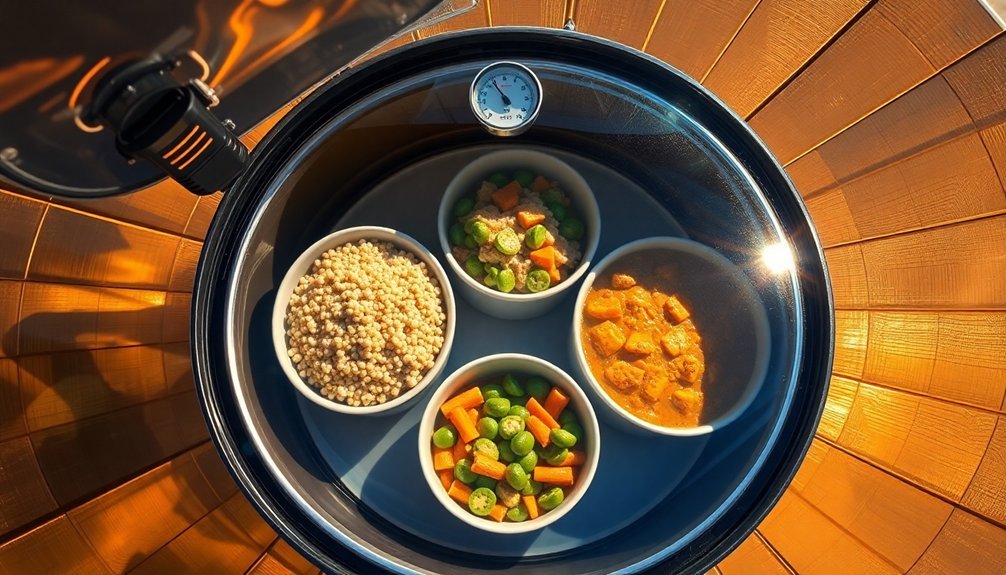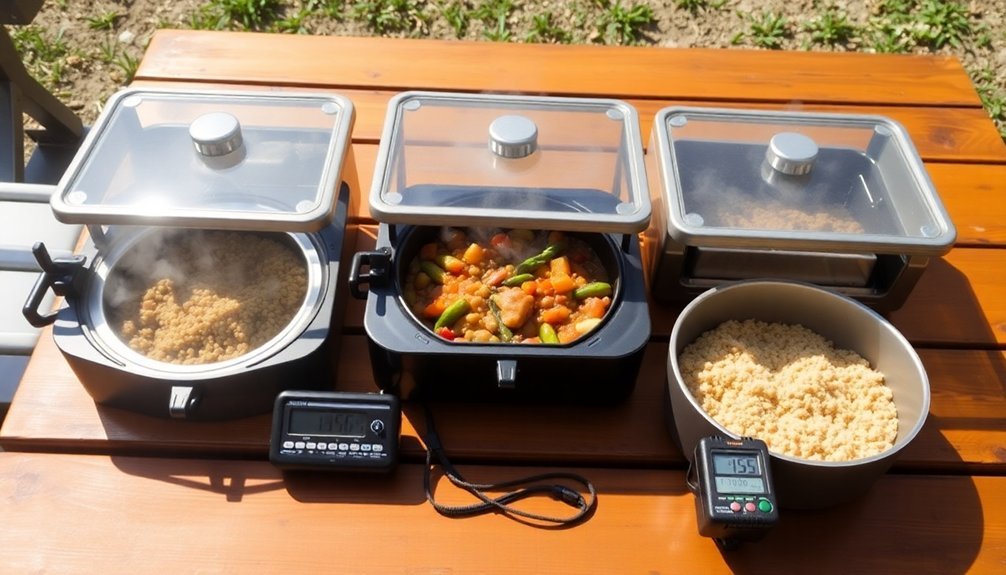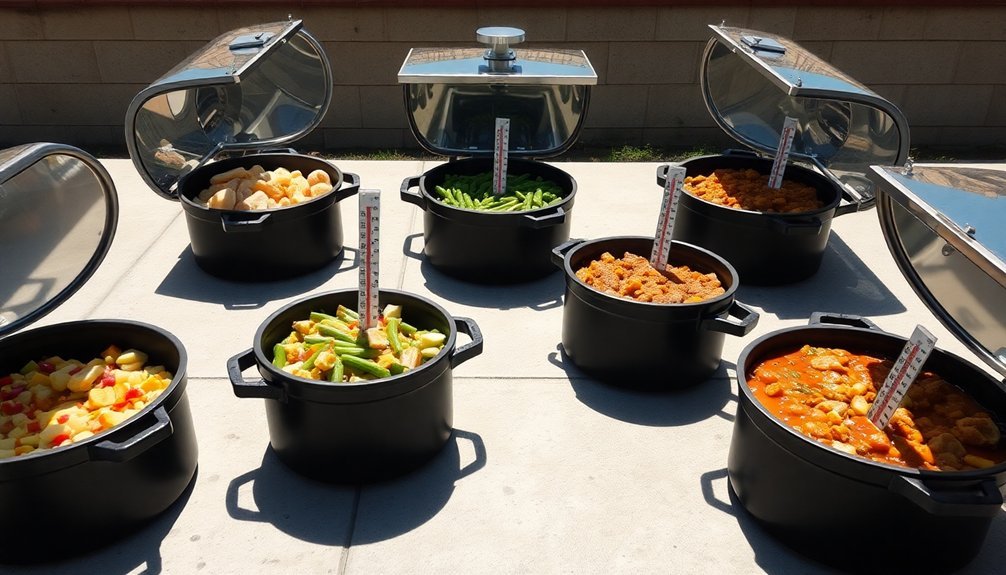Solar oven cooking times vary based on your recipe and sunlight conditions, but you'll want to know these five key timeframes. Quick dishes like melted cheese and toasted coconut take just 15-20 minutes, while popular one-hour recipes include frittatas and tandoori chicken. Two-hour meals perfect for solar cooking are scones and cobblers, giving you time for proper browning. Three-hour slow cooking works best for beans and tender meats, while extended cooking projects require careful monitoring throughout the day. Understanding these time ranges will help you plan your solar cooking strategy and reveal the full potential of your sun-powered kitchen.
Quick Solar Cooking Under Hour

Quick solar cooking offers a sustainable way to prepare food in under an hour, but achieving fast results depends on several key factors.
For the fastest cooking times, you'll want to use a parabolic cooker that can reach temperatures over 800°F, though box ovens that hit 325-400°F also work well.
To cook simple dishes under an hour, use dark-colored or black cookware to maximize heat absorption. Consider moving your cooker to a wind-protected location to maintain consistent temperatures.
You'll get the best results between 10 am and 2 pm when the sun is strongest. During this peak time, you can prepare quick items like baked eggs, omelets, toasted coconut, and melted cheese dishes.
For ideal results, position your solar cooker in direct sunlight and avoid light-colored pots and pans, as they won't absorb heat effectively.
Popular One Hour Recipes
Several delicious recipes can be prepared in a solar oven within an hour, making them perfect for efficient sun-powered cooking.
You'll find breakfast favorites like frittatas and open-faced omelets that take 35-45 minutes, while protein-rich dishes like tandoori chicken require just 35 minutes. For baked goods, try pumpkin scones that cook in 32-35 minutes.
Side dishes offer plenty of quick options too. You can prepare grilled vegetables in 25-35 minutes or solar-baked sweet potatoes in 35-50 minutes. Solar cooking produces meals with even heat distribution due to minimal air movement inside the oven.
If you're looking for a light meal, shrimp and lemon skewers cook up in just 15-20 minutes.
Remember to preheat your solar oven for 30 minutes and use dark cookware to achieve these ideal cooking times, especially during peak hours between 11 am and 3 pm.
Two Hour Solar Meals

While one-hour recipes are great for busy days, longer cooking times often yield richer flavors and more complex dishes in your solar oven.
You'll find several recipes that perfectly fit the two-hour timeframe.
Solar scones need 1.5-2 hours to achieve the right texture, with uncovered browning in the final 30 minutes. The peach blackberry cobbler requires similar timing of 1.5-2 hours until the crust browns perfectly.
For a hearty meal, try Campers Beef Stew, which develops rich flavors over 1.5-2 hours in a dark, lidded pot.
Mango Banana Bread takes 1-2 hours and comes out beautifully in a dark glass dish.
Even quick-cooking shrimp can be adapted for solar cooking – though traditionally a 20-minute recipe, you can slow-cook Shrimp & Lemon Skewers for deeper flavor absorption.
Remember to reposition your solar oven as needed to maintain ideal temperature throughout these longer cooking times.
Three Hour Slow Cook
For dishes that require extended cooking periods, solar ovens excel at three-hour slow cooking sessions. You'll find this timeframe perfect for cooking dry beans, preparing apple fondant cake, or making hearty Basque chicken dishes.
Remember, you're working with nature's heat, so timing will vary based on weather conditions.
To maximize your three-hour cooking window, position your oven between 11 am and 3 pm when the sun's at its strongest. You'll need to reposition your cooker every 10-15 minutes to follow the sun's path.
Using dark-colored pots and keeping food covered will help maintain consistent temperatures. For best results, cut larger ingredients into smaller pieces and stir liquids regularly.
While cooking times are longer than traditional methods, you'll achieve tender, flavorful results with minimal energy consumption.
Extended Solar Cooking Projects

Long-term solar cooking projects demand both careful planning and dedicated preparation to achieve ideal results.
When you're tackling extended cooking sessions, you'll need to maintain consistent sunlight exposure between 11:00 am and 3:00 pm, adjusting your oven's position as the sun moves across the sky.
For these lengthy projects, you'll want to optimize your setup by double-checking your insulation and ensuring your reflector flaps are secured at the perfect angle.
Use dark cookware to maximize heat absorption, and don't forget to place an oven thermometer inside to monitor temperature stability.
If you're cooking meat, marinate it beforehand and rotate it regularly for even results.
On partly cloudy days, you might need to extend your cooking time and pay extra attention to maintaining adequate heat levels.
Frequently Asked Questions
Can I Solar Cook on Cloudy Days?
Yes, you can solar cook on cloudy days, but you'll need longer cooking times and should choose forgiving foods like beans or stews. It's less efficient, so aim for cooking between 10am-4pm for best results.
How Do I Prevent Food From Drying Out in a Solar Oven?
Use a tight-fitting lid on your cookware and keep the solar oven well-sealed. You'll want to pre-heat the oven, use dark cookware, and maintain proper moisture levels by venting steam when needed.
Is It Safe to Leave a Solar Oven Unattended While Cooking?
While you can leave a solar oven briefly, it's safer to check it every 1-2 hours to adjust positioning and monitor food. Don't leave it unattended if you've got raw meat cooking or children nearby.
What's the Maximum Temperature a Solar Oven Can Reach?
You'll find that parabolic solar ovens can reach the highest temperatures, up to 800°F (427°C). However, most home solar ovens typically operate between 150°F (66°C) and 400°F (204°C) under ideal conditions.
Can I Use Aluminum Foil Instead of Dark Cookware?
While you can use aluminum foil, it's not recommended. You'll get better results with dark cookware since it absorbs heat better. Foil reflects heat rather than absorbing it, making your cooking less efficient.
In Summary
You'll find solar cooking times aren't set in stone – they depend heavily on sun intensity, outdoor temperature, and your oven's design. Start with quick 30-minute recipes and work your way up to longer projects. Keep a cooking journal to track your results and adjust times accordingly. Once you've mastered these basic timeframes, you'll confidently tackle any solar cooking challenge that comes your way.





Leave a Reply